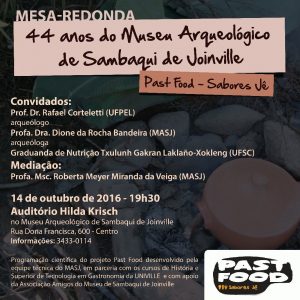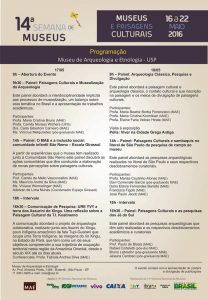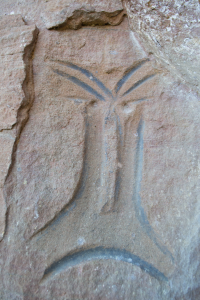Past Food: Jê flavors
“Past food” is a public outreach program integrating archaeology, gastronomy, ethnography and ethnology led by Museu Arqueológico de Sambaqui de Joinville. This edition will taste the “Jê flavors”.

V Congresso Latino-Americano de Arqueometria (CLA 2016)
The University of São Paulo will be held the V Congresso Latino-Americano de Arqueometria (CLA 2016) next November.
Click here for more details.
Excavations at Bonin Site, Urubici, Santa Catarina
Take a look in Rafael Corteletti interview for “Vivendo Mundo Afora” in the excavations of the Bonin site, Urubici, Santa Catarina. Subtitles available in English!
Jê Landscapes of Southern Brazil in the 10th SAB-Sul Meeting –
The 10th meeting of the SAB-Sul (Southern regional center of Brazilian Society of Archaeology) will be held in the city of Pelotas – Rio Grande do Sul, at UFPEL (Federal University of Pelotas) between 18th and 21st October 2016.
One of the symposiums of the Meeting is organized by researchers of the JLSB project with colleagues from Argentina and Uruguay.
Take a look in the abstract below (in Portuguese) of the symposium number 7: Built landscapes and spheres of interaction: processes, experiences and case studies along the medium and late Holocene.
The subscription dealine is on May 10.
For more informations of the Meeting click here.
Simpósio 7
Título: Paisagens construídas e esferas de interação: processos, experiências e estudos de caso durante o Holoceno médio e tardio.
Coordenadores: Rafael Corteletti, Camila Gianotti, Mariano Bonomo
Durante o Holoceno médio e tardio, em diversas zonas do leste da bacia do Rio de La Plata, em especial no sul do Brasil, Uruguai e Nordeste da Argentina, se instalaram distintas populações indígenas que ativaram uma transformação progressiva do meio ambiente a partir do manejo florestal e da construção de arquiteturas com terra, pedras e inclusive valvas que delimitaram espaços sociais e deram lugar a processos de afirmação territorial e conformação de comunidades de média e grande escala. O renovado trabalho arqueológico realizado nessas regiões combinado com novos avanços conceituais e metodológicos nos permitem discutir com maior profundidade questões relacionadas a existência ou não de diferenças sociais no interior das comunidades, a escala e a natureza do impacto humano sobre essas paisagens e o papel das redes de interação regionais de uma forma que não era possível antes. Cada uma destas experiências constituem trajetórias adaptativas e históricas que resultaram em níveis de complexidade sociais variáveis e flutuantes durante o Holoceno médio e tardio. Sambaquis, casas subterrâneas, montículos, complexos de recintos e montículos, campos elevados, aterros, canais,cairnes, chenques, entre outras, foram diferentes soluções arquitetônicas e experiências de manejo do meio que configuraram paisagens construídas que hoje são visíveis e sobrevivem depois de séculos de erosão e alterações modernas.
Neste simpósio nos interessa conhecer a variabilidade da materialidade arqueológica, e suas implicâncias em termos sociais, econômicos, políticos e simbólicos, enquanto práticas e meios materiais e imateriais de regulação da interação social, das tecnologias de produção e de conformação de comunidades originadas em temporalidades e espacialidades diversas. Assim sendo o debate fornecerá uma visão geral dos recentes desenvolvimentos na arqueologia da região platina para o Holoceno médio e tardio, seguida por uma discussão de como esses novos estudos de caso em escala local estão desafiando as propostas em escala suprarregional e mudando nossos pontos de vista sobre as esferas de interação relacionadas a complexidade social, a construção de paisagens, aos padrões da comunidade, a arquitetura cerimonial / funerária, a economia de subsistência e as mudanças naturais e as induzidas pela sociedade humana na paisagem durante o Holoceno médio e tardio.
10th SAB-Sul Meeting – Pelotas, Brazil
The 10th meeting of the SAB-Sul (Southern regional center of Brazilian Society of Archaeology) will be held in the city of Pelotas – Rio Grande do Sul, at UFPEL (Federal University of Pelotas) between 18th and 21st October 2016.
The goal of the scientific meetings of SAB-Sul is to bring together researchers, students, professionals and general people interested in the archaeology field.
The 10th SAB-Sul Meeting will be a place to disseminate research results, communication of work in progress, and proposed theoretical and methodological discussions.
Looking for integration of researchers and the composition of wider scientific work networks, this year, besides the traditional meeting of the SAB-Sul, the event will be held in conjunction with the “III Jornadas de Atualização em Arqueologia Tupi-Guarani” (3rd Update Seminar in Tupi-Guarani Archaeology), seeking to gather researchers from all Mercosur.
For more informations about the meeting click here.
Jê Landscapes of Southern Brazil pannel in the 14th Semana de Museus at Museu de Arqueologia e Etnologia – USP

In May 18th will be place a pannel about the Jê Landscapes of Southern Brazil project in the 14th Semana de Museus at Museu de Arqueologia e Etnologia, USP, São Paulo.
Mark Robinson

Mark is an Associate Research Fellow in the Department of Archaeology at the University of Exeter. He earned his Ph.D. from Louisiana State University on the Underwater Maya project in Belize, studying resource exploitation and wood selection behaviour. Over a decade of field work in Belize has taken him from the inundated salt works of the coast, to the ceremonial centres on the interior and the intricate cave systems of the mountains. Recent research on the archaic and paleoindian periods has recovered the oldest skeletal material in the region.
In Brazil, Mark’s research focuses on the adaptations and transformations of people and the environment, and the identification of social and ritual structures in the southern Brazilian highlands, employing interdisciplinary methods from archaeology, anthropology, ecology, soil science, and geography. Further research in Amazonia expands the examples of human environment interaction in the tropical and sub-tropical Americas.
Manoella Souza Soares

Coming Soon
Fabiana Merencio

Coming soon.
Bruno Labrador

Coming Soon
Jê Landscapes of Southern Brazil | Privacy Policy
